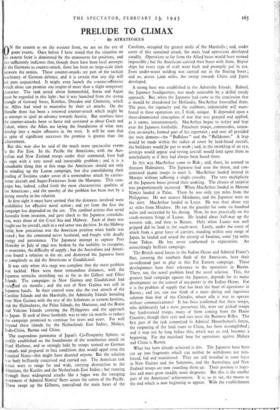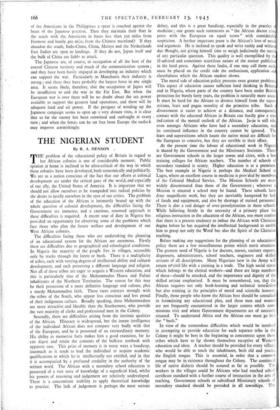PRELUDE TO CLIMAX
By STRATEGICUS N the eastern as on the western front, we are on the eve of great "events. Once before I have stated that the situation on the eastern front is dominated by the manoeuvre for positions, and this sufficiently indicates that, though there have been local attempts of the Germans to counter-attack, there has been no large-scale clash between the armies. These counter-attacks are part of the tactical machinery of German defence, and it is certain that any slip will not pass unpunished. It might even launch the counter-offensive which alone can promise any respite of more than a slight temporary character. The tank attack about Sommerfeld, Sorau and Sagan must be regarded in this light ; but it was launched from the strong triangle of forward bases, Kottbus, Dresden and Chemnitz, which the Allies had tried to neutralise by their air attacks. On the Danube there has been a renewed counter-attack which might be an attempt to spoil an advance towards Austria. But nowhere have the counter-attacks been so fierce and sustained as about Goch and Calcar, where the Allies are laying the foundations of what may develop into a major offensive in the west. It will be seen that in spite of significant successes the promise is greater than the achievement.
But this may also be said of the much more spectacular events in the Far East. In the Pacific the Americans, with the Aus- tralian and New Zealand troops under their command, have had to cope with a very novel and intractable problem ; and it is a remarkable thing that at this stage the Americans should not only be winding up the Luzon campaign, but also consolidating their landing of Iwojima under cover of a tremendous attack by carrier- borne aircraft and Super-Fortresses from the Marianas. This cam- paign has, indeed, called forth the most characteristic qualities of the Americans ; and the novelty of the problem has been met by a daring novelty in the solution.
At first sight it must have seemed that the distances involved were prohibitive for effective naval action ; and yet from the first the campaign has depended on the sea. The cardinal actions that saved Australia from invasion, and gave check to the Japanese consolida- tion, were those of the Coral Sea and Midway. Each of them was fought out by aircraft, each in a real sense was decisive. In the Midway battle, how precarious was the American position when battle was joined ; but the command never hesitated, and fought with deadly energy and persistence. The Japanese attempt to capture Port Moresby in July of 1942 was broken by the inability to recognise, or overcome, the difficulty of supply ; but the Australians and Ameri- cans found a solution in the air, and destroyed the Japanese force as completely as did the Americans at Guadalcanal.
It was only when this stage was complete that the main- problem was tackled. Here were these tremendous distances, with the Japanese tentacles stretching out as far as the Gilbert and Ellice Islands. The campaigns in New Guinea and Guadalcanal had occupied six months ; and the rest of New Guinea was still in Japanese hands. In their control were also the vast stretch of the Caroline Islands and the Marshal's, the Admiralty Islands brooding over New Guinea with the rest of the Solomons as eastern bastions, and the Halmaheras, the Palau Islands, the Marianas, and the Bonin and Volcano Islands covering the Philippines and the approach to Japan. If each of these footholds was to take six months to reduce the campaign promised to continue for years and years. For well beyond these islands lay the Netherlands East Indies, Malaya, Indo-China, Burma and China.
The stupendous panorama of Japan's Co-Prosperity Sphere, so swiftly established on the foundations of the treacherous attack on Pearl Harbour, and so strongly held by troops trained on German manuals and prepared to face conditions that would appal even the fanatical Nazis—this might have daunted anyone. But the solution was both brilliantly conceived and carried out. The American task forces were to range far and wide, carrying destruction to the Aleutians, the Kuriles and the Netherlands East Indies ; but running through these widespread attacks like a fugue was the sweeping movement of Admiral Nimitz' fleets across the centre of the Pacific. These swept up the Gilberts, neutralised the main bases of the Carolints, occupied the greater atolls of the Marshal's; and, under cover of this sustained attack, the main land operations developed steadily. Operations so far from the Allied bases would have seemed impossible ; but the Americans carried their bases with them. Repair ships for every type of craft were built and promptly put in use. Even under-water welding was carried out in the floating bases ; and so, across 5,000 miles, the sweep towards China and japan developed.
A strong base was established in the Admiralty Islands. Rabaul, the Japanese headquarters, was made untenable by a skilful steady approach. But, when the Japanese had come to the conclusion that it should be abandoned for Hollandia, MacArthur forestalled them. The pace, the ingenuity and the stubborn, indomitable will mani- fested in these operations are, I think, unique. It depended upon a three-dimensional conception of war that was grasped and applied, as it seems, instantaneously. MacArthur began to isolate and leap over the Japanese footholds. Parachute troops,sommandos, satura- tion air-attacks, formed part of his repertoire ; and over all presided the twin demons—the "Buffaloes" and the "Bulldozers." A leap would be made within the radius of cover by land-based aircraft, the bulldozer would be put to work ; and, in the twinkling of an eye, airstrips would appear and roving aircraft would laud upon them as nonchalantly as if they had always been based there.
In this way MacArthur came to Biak ; and, there, he seemed to threaten Halmahera. The Japanese had seen the threat, and con- centrated 30,000 troops to meet it. MacArthur landed instead in ' Moratai without suffering a single casualty. The very multiplicity of the Japanese bases proved their undoing. The chance of surprise was proportionately increased. When MacArthur landed in Moratai Nimitz landed in Palau. There he was only 550 miles from the Philippines. He was nearest Mindanao, and the Japanese were on the alert. MacArthur landed in Leyte. He was then about 250 air miles from Mindoro. He ran the gauntlet for some six hundred miles and succeeded by his daring. Now, he was practically on the south-western fringe of Luzon. He landed about half-way up the western side, and then in Bataan. Only when Luzon was well gripped did he land in the south-west. Lastly, under the cover of attack from a great force of carriers, standing within easy range of Japan, he landed and seized the airstrip of Iwojima, some 750 miles from Tokyo. He has never conformed to expectation. An astonishingly brilliant campaign.
The British naval forces in the Indian Ocean and Admiral Fraser's fleet, covering the southern flank of the Americans, have their co-ordinated part to play in this Far Eastern campaign. These developments have their relevance to the operations in Burma. There, too, the novel problem bred the novel solution. This, the greatest land campaign against the Japanese, depends for its major development on the control of sea-power in the Indian Ocean. For it is the problem of supply that has been the bane of operations in Burma ; and yet, can one think of a more daring and ingenious solution than that of the Chindits, whost :Ole it was to operate without communications? It has been confirmed that these troops, who deliberately led a most precarious life, were not picked troops but hard-trained troops, many of them coming from the Home Counties, though their eyes and ears were the Burmese Rifles. The first part of the task committed to Admiral Mountbatten's forces, the reopening of the land route to China, has been accomplished ; and it may not be long before this, which was an end, becomes a beginning. For the mainland base for operations against Malaya and China is Burma.
What has been already achieved is this. The Japanese have been cut up into fragments which can neither be withdrawn nor rein- forced, fed and munitioned. They are still installed in some force in New Guinea and the Solomons, and the Australians and New Zealand troops are now rounding them up. Their position is hope- less and must grow steadily more desperate. But this is the smaller part of the Americans' achievement. It is, so to say, the means to the end which is now beginning to appear. With the establishment of the Americans in the Philippines a spear is couched against the heart of the Japanese position. Dare they maintain their fleet in the south with the Americans in bases less than 250 miles from Formosa and barely ano mi:es from the Chinese mainland? If they abandon the south, Indo-China, China, Malaya and the Netherlands East Indies are open to landings. If they do not, Japan itself and the bulk of China are liable to attack.
The Japanese are, of course, in occupation of all the best of the coastal Chinese territory and much of the communication system ; and they have been busily engaged in developing an industry which can support the war. Particularly in Manchuria their industry is strong ; and there they have probably the largest force in any single area. It seems likely, therefore, that the occupation of Japan will be insufficient to end The war in the Far East. But when the European war is over there will be no doubt about the sea power available to support the greatest land operations, and there will be adequate land and air power. If the prospect of winding up the Japanese campaign seems to open up a very distant vista, it is clear that so far the enemy has been outwitted and outfought at every turn ; and when the forces can be set free from Europe the oudock may improve astonishingly.



























 Previous page
Previous page